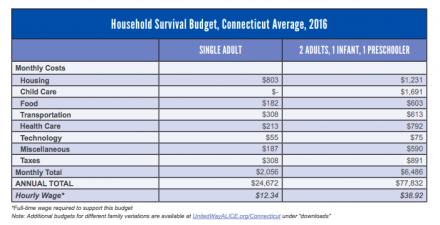
In Connecticut, 40 percent of households, including 70 percent in Bridgeport, have income which falls below what is needed to cover basic necessities of housing, food, child care, health care, technology and transportation, according to the 2018 ALICE Report conducted by United Way of Connecticut. ALICE stands for Asset Limited Income Constrained Employed. See the report here. See CT Mirror story here.
News release from United Way:
United Ways in Connecticut and seventeen other states are promoting the ALICE initiative to place a spotlight on a large population of residents who are working, but have difficulty affording a basic Household Survival Budget. The new ALICE Report uses data from a variety of sources, including the U.S. Census and the American Community Survey to quantify the number of households in Connecticut’s workforce that are struggling financially.
The new ALICE Report on financial hardship takes a deeper look at the growing financial challenges that require more and more working and middle class families to make tough choices every day as they manage their household budget. Consider these findings in the new ALICE Report:
Despite working hard, 30% of Connecticut households (404,035) have earnings above the federal poverty line but under a basic cost-of-living threshold. United Way calls these households ALICE.
Combined with those in poverty, 40% of Connecticut households cannot afford the basics of housing, food, health care, child care, technology and transportation (538,529 households).
It costs nearly $78,000/year for a family of four with 1 infant and 1 toddler to pay for the basic needs in the Household Survival Budget.
The report maps out where ALICE families live, demonstrating that ALICE lives in every city and town in Connecticut. In every city and town in the state, at least 10% of households are ALICE households.
55% of jobs in Connecticut pay $20/hour or more, which is among the highest in the country, but only one of the top 20 occupations in Connecticut (in terms of number of jobs) pays enough to support the ALICE Household Survival Budget.
In Connecticut, almost half of households do not have the savings to cover three months of living expenses, risking a real financial spiral in the event of a typical family emergency (illness, car breakdown, appliance replacement, etc.).
In addition, the new ALICE Report reveals the following trends affecting ALICE:
Differences in financial security by age, race, and ethnicity persist, creating challenges for ALICE families.
The growth in the “gig” economy and on-demand employment is shifting more financial risk to workers and ALICE households.
ALICE families are more vulnerable to an unexpected emergency, because it is becoming more difficult to save and build assets.
The changing composition of households are part of the ALICE story.
The wealth-health gap in America leads to health insecurity.
And the new ALICE Report provides many more insights into the causes and consequences of financial hardship.The ALICE Report recommends both short-term and long-term strategies to help ALICE families and strengthen our communities. Connecticut’s United Ways are responding to provide a hand up for ALICE households through a number of these short-term and long-term strategies.
Connecticut’s United Ways are helping working families to increase their financial security by building a life-long habit of saving. United Ways are promoting SaverLife Connecticut, which combines a goal-based savings incentive program digital financial coaching and online resources.
United Ways are working to help ALICE families build their assets and savings by supporting tax preparation at VITA sites where eligible families can secure tax credits (EITC, CTC) and begin saving, and through financial education and budget coaching.
United Ways advocate for long-term policy solutions that can lead to more financial security for ALICE.United Ways engage with businesses, government agencies, other nonprofits, the faith-based community, civic leaders and anyone who wants to work toward individual and community wide solutions that lead to more financial security for ALICE households.
The Connecticut ALICE Report was funded by the 16 Connecticut United Ways. To download the completed 2018 Connecticut ALICE report click HERE or visit alice.ctunitedway.org.
In addition, an online simulator is also available to experience the financial challenges that ALICE households in Connecticut face every day at www.MakingToughChoices.org.About Connecticut United Ways
Connecticut United Ways advance the common good by creating opportunities for all, with a particular focus on education, income/financial security, health, and basic needs–the building blocks for a good quality of life. We engage people and organizations throughout our communities who bring passion, expertise, and resources needed to get things done, and we invite everyone to be part of the change.


*** The best way to help Bpt. family residents is to raise taxes & city services, no? ***WHAT SAY YOU***
These are sobering statistics. It unfortunate that this posting has gotten so little attention from the OIB crowd. These numbers reiterate that we have TWO states of Connecticut;ONE Rich and ONE POOR. Since it is Labor Day I am attaching an articles that shows why we have Labor Day. It’s unfortunate that,even here on OIB,there are people who demonize unions.
https://www.msn.com/en-us/news/us/the-searing-photos-that-helped-end-child-labor-in-america/ar-BBML894?
Frank, really, you know why this posting has gotten so little attention from the OIB crowd, Mojo gave a portion of the reason the rich at the top & the poor on the bottom with the middle-class doing a balancing act between both and getting very tired doing it for so long. Now what goes along with being poor?
Little or no access to the internet
*** Nothing new for America, the rich at the top & the poor on the bottom with the middle-class doing a balancing act between both and getting very tired doing it for so long.***